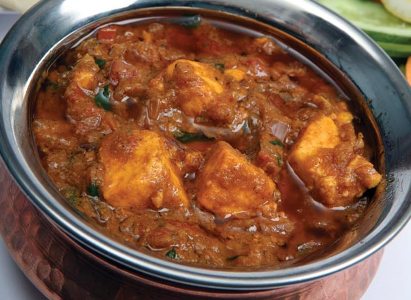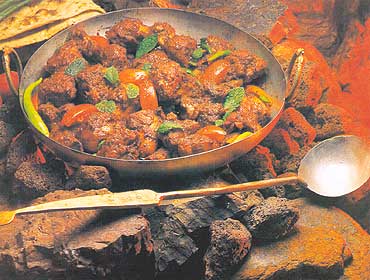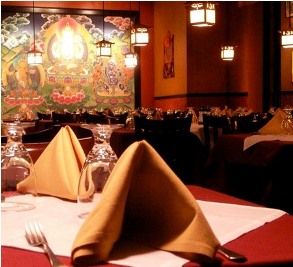Food not only nourishes us, but when well prepared, it can bring excitement, pleasure and contentment. When shared, it can bring dining companions together around the table as they enjoy and comment on delicious dishes. I had a wonderful dining experience recently when I shared some great Nepalese food with colleagues from work. On the last night of a week of meetings to discuss an international scientific project our nations are collaborating on, we shared a meal at a wonderful Nepali restaurant, Himalayan Heritage in DC’s lively Adams Morgan neighborhood.
Although the focus of the restaurant is Nepali cuisine, they also serve a selection of Indian dishes and have a few Tibetan specialties (The noodle soup Thukpa and Momo dumplings) as well. To the delight of vegetarians and omnivores alike, there are many tasty vegetable dishes that can serve as main dishes as well.
We’ve been having some cold, wintry weather recently with lots of snow and ice and blustery cold wind, but the moment we stepped into Himalayan Heritage, it was like stepping in a warm and welcoming Newar village. The fragrance of the food to follow teased us as we walked through the dining room decorated in shades of firelight with wooden beams and detailing and lanterns hanging from the ceiling.
We started our meal with a couple of subcontinental appetizers, a couple of large, delicious, mildly-spiced samosas stuffed with potatoes, peas and onions; and a few small yakitori-sized skewers of sliced chicken that had been marinated in a peanut sauce and grilled – for a Himalayan take on the Indo-Pacific standard. The appetizers came with a selection of condiments: a mildly spicy coriander-mint sauce, a sweet tamarind sauce and a spicy aloo aachar made from potatoes and peas. While we dined and conversed, music like the tune Banchari featured here with birdsong and flutes played softly in the background to complete the Nepali atmosphere.
In a leisurely but timely manner – not too soon and not to slow – our waitress asked if we would like our main courses: Lamb Kadai; Khukhura Ko Masu; Himalayan Karahi and Goa Fish Curry. Our dishes came with plain basmati rice and a bread basket that included plain naan, garlic naan and tandori roti. The bowls were placed in the center of the table community style so we could all taste each one. As we ate we discussed the joy of sharing food at a table, and how much fun it was to comment on the dishes as well as eat them. We all agreed that sharing was best – although, even then, I sensed some reservation from my Canadian colleague.
One of the things that I love about Nepali food, and one of the reasons I consider it a ‘fusion” cuisine, is that there are South Asian and East Asian (and a few Western Asian) elements in the food. Sometimes this mixture of cuisines is found in ingredients and their combinations and other times it is seen in a mixture of preparation methods.
The Lamb Kadai was a straight-off lamb curry. Whenever I dine at subcontinental or Himalayan restaurants, I always order at least one lamb dish – it is one of the ways I rate the restaurant. If they do a good job on the vindaloo or the korma or the kadai, then the meal is off to a great start. The curry we had consisted of tender bits of lamb that just dripped off the fork in a rich tomato-based curry with bay leaves, lots of ginger and cumin and a healthy blast of garam masala. The Nepali version we had was spicy but not hot with the cumin, ginger along with the tomatos as the strongest flavors in the dish. The Nepali version is also a lot saucier and less “sweet” than some of the Indian takes on the dish you may be familiar with because of the different ingredients in the Nepali garam masala.

The Khukhura Ko Masu is a fascinating dish that really blends east and west nicely. First off, it is a chicken curry that starts as a stir fry with ginger, garlic and tomato that is then allowed to simmer in coconut milk just a bit to develop a mild-to moderately spicy sauce. It has a host of western, southern and eastern Asian ingredients that when combined create a really uniquely flavored dish. Although the sauce is a reddish brown from the tomatoes and red onions, it uses a lot of different types of citrus a citrus-like flavors to flavor it, including lemon zest, lime and lemon grass. At one point I got a blast of what could only have been Sichuan pepper and there were also smoky overtones of black cardamom and curry leaves as well. A really delicious dish.

The Himalayan Karahi was another dish that mixed preparation styles first marinating and grilling the meats and then combining them with sweet peppers, tomatoes and cilantro. Now, dishes called “karahi” are eaten from Afghanistan, across the subcontinent and into the Himalayas. These dishes are all named for the iron cooking pot used to cook in. To my knowledge, the Nepalese are the only people in this swath of territory who grill the meat in the karahi (or kadai) and then combine it with other spices and vegetables in for stove top cooking. The meat itself (a combination of chicken and lamb) was tender and delicately flavored with a hint of a citrus bite telling that it was marinated in lemon juice and perhaps ginger and garlic. Surrounding the meat were heaps of delicious sweet peppers and tomatoes with only a small amount of light sauce. A real Himalayan treat!
The Goa Fish Curry had tender but firm chunks of a mild fish (more like a cod than a catfish) in a rich coconut sauce with a gentle tamarind bite and soured with malt vinegar. The Nepali version of the dish was a great deal more mild and balanced than a lot of Indian takes on the dish that I’ve tried. We ordered it to offset the tomato-based curries and dishes that we had on the table and it didn’t disappoint.
I don’t usually say much about the bread at restaurants – for all too often it is but an afterthought or simply a utensil to eat with, but the garlic naan at Himalayan Heritage, served piping hot was nothing short of amazing.
Although stuffed to the brim with wonderful food, we all smiled, glanced at each other and giggled a bit when the waitress asked us if we wanted to see the dessert menu. It was as if we were all thinking, “We know we shouldn’t, but yes please, miss, can we have some more.” So, the men ordered a couple of Himalayan rice puddings called Keer – which my Canadian colleague announced that HE WOULD NOT SHARE! Which made us all laugh again. And the lady sitting next to me split a Halwa with me.
The Keer was delicious (I snuck a taste when the Canadian was off at the lieu) and I completely understand why he wouldn’t (willingly) share it. It is a rice pudding in which the rice is cooked in a mixture of coconut and cow’s milk until it quite soft. The Nepali version we had was flavored with rosewater, cardamom and sliced pistachios and served chilled. The additions to the dessert can vary quite a bit to include raisins and other types of nuts. Often sweetened with jaggery, nowadays white sugar is also commonly used.
The Halwa was also delicious. To the surprise of some of you, perhaps, it is a carrot-based dessert that is eaten widely throughout Central and South Asia and the Himalayas. The carrots are grated and boiled in a whole milk or as we had in a mixture of coconut and whole cow’s milk until they are soft. Then they are flavored with cardamom, raisins and sliced almonds and pistachios. A different and perhaps more healthy dessert than is often eaten.
After the meal we cabbed back to the hotel one of the scientists was staying at and went our separate ways. The sharing of the meal, however, brought us closer and the memory of it will continue to unite us, even when so far apart. That is to me, one of the wonders of food, how it creates and sustains bonds between people. Eating is a sensual experience, and sharing a meal – even if just amongst business partners – is an intimate experience that continues to resonate long after the evening has ended. So, if you are near DC or travelling there, I urge you to visit Himalayan Heritage – and share a meal with someone. (Words by Laura Kelley. Banchari from Dexo Music Center. Images of kadai and karahi dishes from Google photos)

